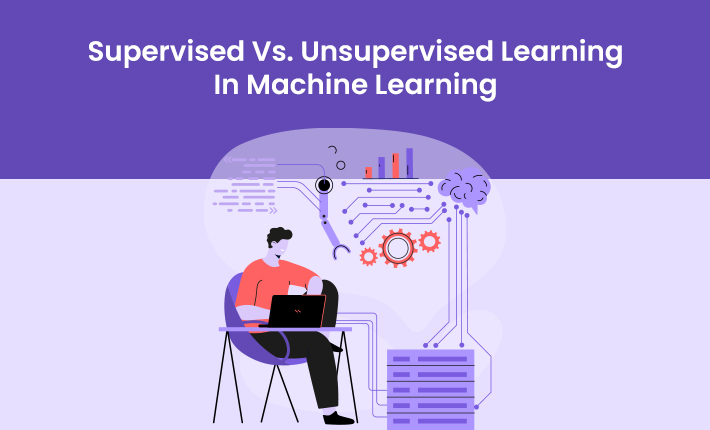Machine learning is a subfield of artificial intelligence that involves the development of algorithms and statistical models that allow computer systems to learn and improve from experience. There are two main types of machine learning: supervised learning and unsupervised learning. In this article, we will provide a beginner's guide to supervised and unsupervised learning in machine learning.
What Is Supervised Learning?
Supervised learning is a type of machine learning that involves training a model on a labeled dataset. A labeled dataset is a dataset that has already been tagged with the correct output. For example, if we were training a model to recognize images of cats and dogs, a labeled dataset would include images of cats labeled as "cat" and images of dogs labeled as "dog".
Supervised learning algorithms use these labeled datasets to learn the relationship between the input data and the output labels. The goal of supervised learning is to use this learned relationship to make predictions on new, unseen data. In other words, supervised learning algorithms are trained to generalize from the training data to make predictions on new, unseen data.
Some common examples of supervised learning algorithms include regression, classification, and neural networks. Regression algorithms are used to predict continuous values, while classification algorithms are used to predict discrete values. Neural networks are a type of algorithm that is inspired by the structure and function of the human brain and are often used for image and speech recognition tasks.
Supervised Machine Learning Methods
Supervised learning is a type of machine learning where the algorithm learns to predict an output variable based on input variables, using a labeled dataset for training. In supervised learning, the algorithm learns to generalize from the training data to make predictions on new, unseen data. Here are some of the most commonly used supervised machine learning methods:
Regression
Regression is a type of supervised learning where the goal is to predict a continuous output variable, such as a price or a temperature. Regression algorithms learn a mapping between input variables and a continuous output variable, and can be used for a wide range of applications, including finance, economics, and engineering.
Some common regression algorithms include linear regression, logistic regression, and polynomial regression.
Classification
Classification is a type of supervised learning where the goal is to predict a categorical output variable, such as a yes or no answer or a class label. Classification algorithms learn a mapping between input variables and a categorical output variable, and can be used for a wide range of applications, including image and speech recognition, fraud detection, and medical diagnosis.
Some common classification algorithms include decision trees, random forests, support vector machines (SVM), and artificial neural networks.
Ensemble Methods
Ensemble methods are a type of supervised learning where multiple models are trained and combined in order to improve the accuracy and robustness of the predictions. Ensemble methods can be used for both regression and classification tasks, and are often used in competitions such as the Kaggle machine learning competition.
Some common ensemble methods include bagging, boosting, and stacking.
Deep Learning
Deep learning is a type of supervised learning where artificial neural networks with multiple layers are used to learn complex patterns and relationships in the data. Deep learning algorithms can be used for a wide range of applications, including image and speech recognition, natural language processing, and autonomous driving.
Some common deep learning algorithms include convolutional neural networks (CNN), recurrent neural networks (RNN), and long short-term memory (LSTM) networks.
Conclusion Supervised learning methods are an important tool in machine learning, and can be used for a wide range of applications. Regression, classification, ensemble methods, and deep learning are just a few of the most commonly used supervised learning methods. By understanding the strengths and weaknesses of these methods, you can choose the right technique for your machine learning task.
What Is Unsupervised Learning?
Unsupervised learning is a type of machine learning that involves training a model on an unlabeled dataset. An unlabeled dataset is a dataset that does not have any predefined output labels. Instead, unsupervised learning algorithms try to find patterns and relationships in the input data without any prior knowledge of what the output should be.
Unsupervised learning algorithms are often used for clustering and dimensionality reduction tasks. Clustering algorithms are used to group similar data points together, while dimensionality reduction algorithms are used to reduce the number of features in a dataset while preserving the important information.
Some common examples of unsupervised learning algorithms include k-means clustering, hierarchical clustering, and principal component analysis (PCA).
Unsupervised Machine Learning Methods
Unsupervised learning is a type of machine learning where the algorithm learns patterns and relationships in data without explicit guidance or labeled examples. In unsupervised learning, the goal is to identify hidden structures or groups within the data, such as clusters or associations. Here are some of the most commonly used unsupervised machine learning methods:
Clustering
Clustering is a method of grouping similar data points together in order to identify patterns and relationships within a dataset. It involves dividing data points into groups based on their similarities, using similarity measures such as distance or density. Clustering algorithms can be used for a wide range of applications, including customer segmentation, image and text classification, and anomaly detection.
Some common clustering algorithms include k-means clustering, hierarchical clustering, and DBSCAN.
Dimensionality Reduction
Dimensionality reduction is the process of reducing the number of features or variables in a dataset while preserving the important information. It is often used to simplify complex datasets and make them easier to analyze. Dimensionality reduction techniques can be either linear or nonlinear, and can be used for a wide range of applications, including image and speech recognition, signal processing, and data compression.
Some common dimensionality reduction techniques include principal component analysis (PCA), t-distributed stochastic neighbor embedding (t-SNE), and autoencoders.
Association Rule Learning
Association rule learning is a method of discovering relationships between variables in a dataset. It involves identifying frequent patterns or associations among the variables, and using these patterns to make predictions or recommendations. Association rule learning is often used in market basket analysis and recommendation systems, where it is used to identify patterns in consumer behavior and make personalized recommendations.
Some common association rule learning algorithms include Apriori and FP-growth.
Anomaly Detection
Anomaly detection is the process of identifying data points that are significantly different from the rest of the data. It is often used in fraud detection, intrusion detection, and other applications where detecting rare events is important. Anomaly detection algorithms can be either unsupervised or supervised, and can be based on statistical models, machine learning algorithms, or a combination of both.
Some common anomaly detection algorithms include isolation forest, one-class SVM, and local outlier factor (LOF).
Unsupervised learning methods are an important tool in machine learning, and can be used for a wide range of applications. Clustering, dimensionality reduction, association rule learning, and anomaly detection are just a few of the most commonly used unsupervised learning methods. By understanding the strengths and weaknesses of these methods, you can choose the right technique for your machine learning task.
Note -
Supervised and unsupervised learning are two main types of machine learning. Supervised learning involves training a model on a labeled dataset, while unsupervised learning involves training a model on an unlabeled dataset. Both types of learning have their own unique applications and can be used to solve a wide range of problems in machine learning. By understanding the differences between supervised and unsupervised learning, you can choose the right type of learning for your machine learning tasks.
Supervised Learning vs. Unsupervised Learning: Key Differences
Supervised learning and unsupervised learning are two broad categories of machine learning, with some key differences between them. Here are some of the main differences between supervised and unsupervised learning:
Training Data
Supervised learning algorithms require labeled training data, where each data point is associated with a known output value. The algorithm learns to predict this output value based on input variables. Unsupervised learning algorithms, on the other hand, do not require labeled training data. They learn to identify patterns and relationships in the data without any explicit guidance.
Goal
In supervised learning, the goal is to learn a mapping between input variables and output variables, and to generalize this mapping to new, unseen data. The output variable may be continuous, as in regression, or categorical, as in classification. In unsupervised learning, the goal is to identify hidden patterns and structures in the data, such as clusters or associations.
Performance
Supervised learning algorithms can be evaluated based on their accuracy in predicting output values on new, unseen data. Unsupervised learning algorithms, on the other hand, are often evaluated based on their ability to uncover useful patterns or relationships in the data.
Complexity
Supervised learning algorithms can be more complex than unsupervised learning algorithms, as they need to learn a mapping between input and output variables. This requires more data and more computational resources. Unsupervised learning algorithms can often be simpler, as they do not need to learn an explicit mapping between variables.
Applications
Supervised learning algorithms are widely used in applications such as image and speech recognition, fraud detection, and medical diagnosis. Unsupervised learning algorithms are often used in applications such as customer segmentation, anomaly detection, and data compression.
Supervised and unsupervised learning are two broad categories of machine learning, with different goals, performance metrics, and applications. Supervised learning requires labeled training data and aims to learn a mapping between input and output variables. Unsupervised learning does not require labeled training data and aims to identify hidden patterns and structures in the data. By understanding the differences between these two types of learning, you can choose the right approach for your machine learning task.
Supervised vs. Unsupervised Learning: Key Takeaways
Here are some key takeaways about supervised vs. unsupervised learning:
Supervised Learning:
1) Requires labeled training data
2) Learns a mapping between input and output variables
3) Goal is to generalize the mapping to new, unseen data
4) Performance is evaluated based on accuracy in predicting output values
5) Used in applications such as image and speech recognition, fraud detection, and medical diagnosis.
Unsupervised Learning:
1) Does not require labeled training data
2) Learns to identify hidden patterns and structures in the data
3) Goal is to uncover useful patterns or relationships in the data
4) Performance is evaluated based on the ability to uncover these patterns or relationships
5) Used in applications such as customer segmentation, anomaly detection, and data compression
By understanding the differences between supervised and unsupervised learning, you can choose the right approach for your machine learning task. If you have labeled data and want to predict output values, supervised learning may be the way to go. If you have unlabeled data and want to uncover hidden patterns or structures, unsupervised learning may be more appropriate.

















Post Comments